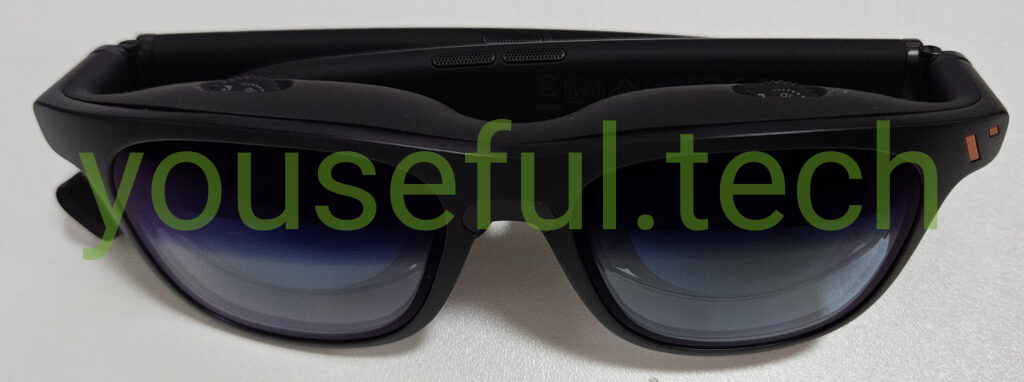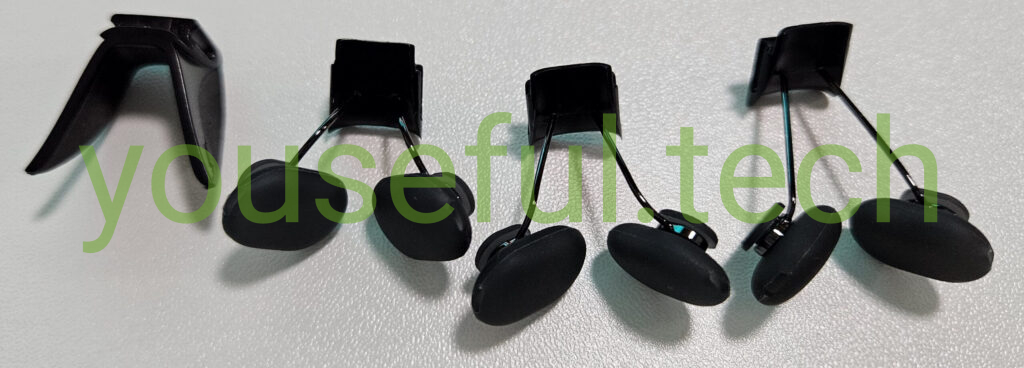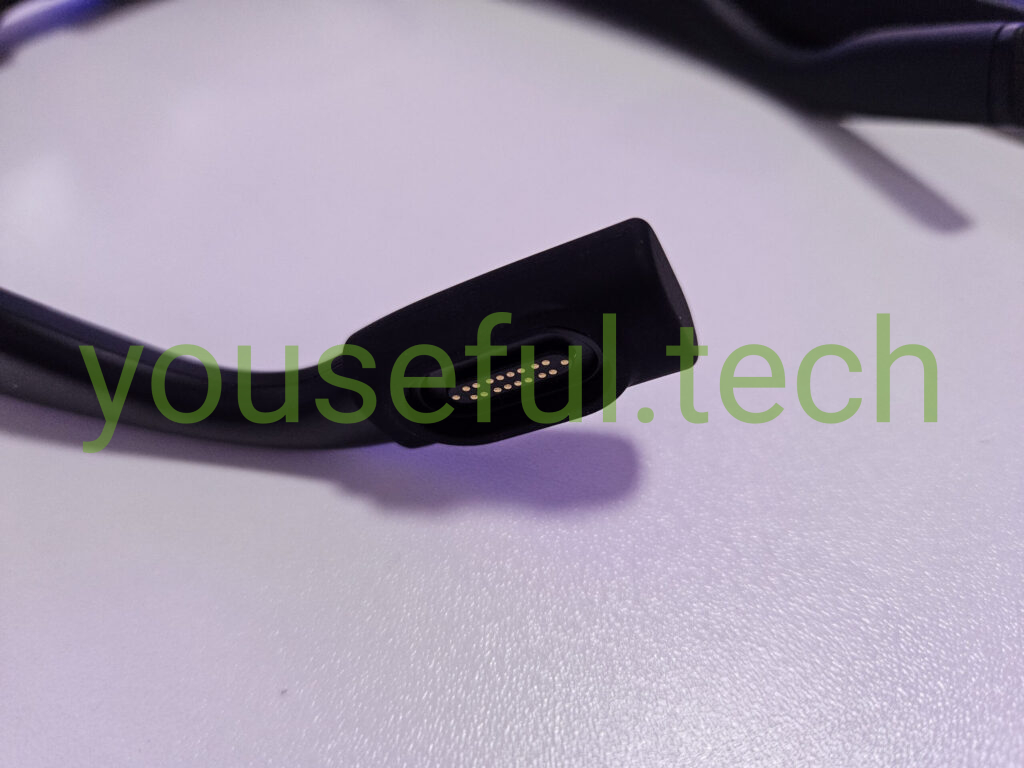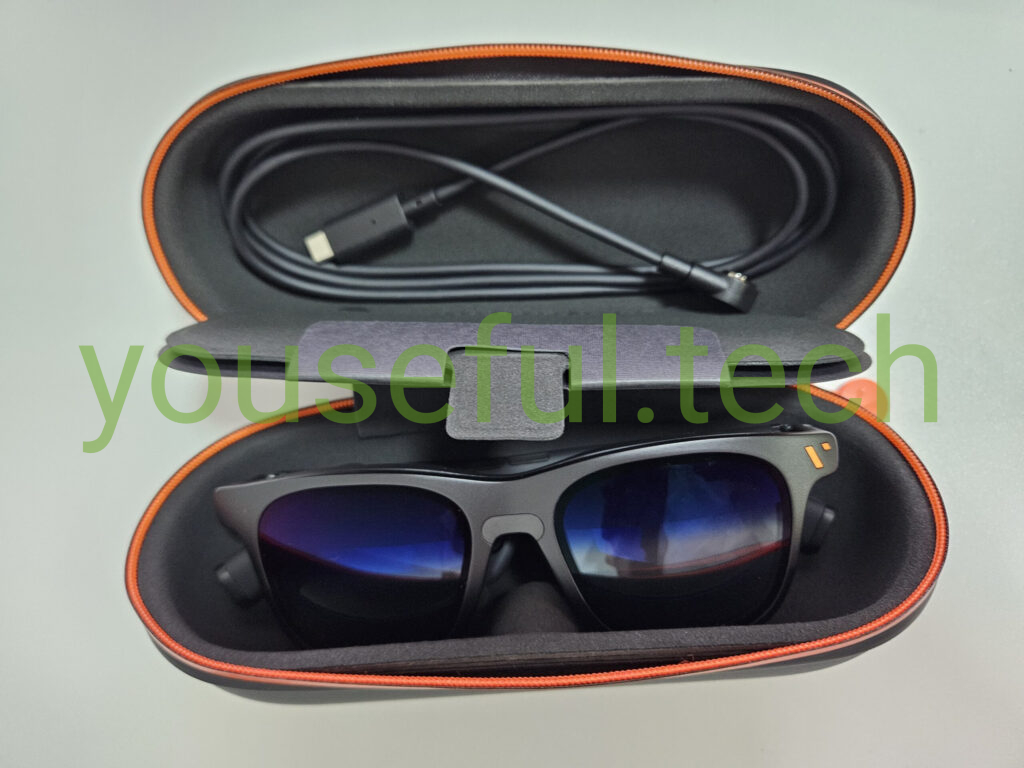What Are These?
The Viture Pro XR are lightly shaded sunglasses that have mini displays in each eye and speakers on the arms. They also have an electrodimming function that can blackout the sunglasses.

Disclosures
Other than those disclosures made conspicuously herein, as of the time of the publishing of this page, the writer(s)/publisher(s) of this content have nothing to disclose.
Modes of Use
Fixed Mode
In this mode the glasses function like a monitor glued to your face. When you move your face, the monitors move as well. Unlike a real monitor or a virtual reality headset, you cannot move your head to see something that is out of view or that is blurry due to being at the edge of your vision. In order to focus on different parts of the screen, you must rotate your eyeballs. You can also make minor adjustments by moving your eyebrows. Therefore, when the display size is too large, you will be unable to see everything or whatever you see may be blurry.
This is the default mode and requires no software or installation. To use this mode, you only need to connect to a device that can output display using DisplayPort and power over a single USB C cable. As of late 2024, almost all new Windows and Mac laptops can do this. As of late 2024, most Android smartphone manufacturer’s highest end smartphones can do this. Generally, lower tier smartphones cannot do this. For example Samsung’s galaxy S series phones (S22, S23, S24) can do this, however their budget models generally cannot. The glasses do not directly support HDMI. With appropriate adapters and enough cables, the glasses can be made to display through HDMI, however given the extra expense, cables, and hassle, this is not recommended.
Virtual Monitor Mode
What This Is
In this mode, the glasses have virtual reality like functions. They can be configured to display a virtual monitor in space that remains fixed as you rotate your head. The glasses must be connected to a device that has appropriate software installed. In this case, a “Space Walker” application that is available for Windows, Mac OS, Android, and IOS.
Windows Space Walker
The Windows software turns the glasses into additional virtual monitors. It does not have additional functionality. The software required no effort to install. The software had every feature I could think of wanting and I encountered no issues with it. It allows customizability in numerous ways:
- Refresh rate of 60hz, 90hz, 120hz
- Additional virtual displays including: ultrawide, 3 monitors side by side, 3 vertical monitors
- You can duplicate the display between your monitor and glasses, or use the glasses as additional virtual monitors
- You can make the virtual monitors closer or father away
- You can choose whether the virtual display moves with your face or not in the following ways: horizontal rotation, vertical rotation, angled rotation (leaning your head the left or right)
Android Space Walker
The Android Space Walker launches a separate virtual application that displays in the glasses. It is not like having an additional monitor on your laptop, but rather only allows you to use this one application. The Space Walker app has a few applications inside of it such as Youtube, Roku, and a web browser. The app was not fully tested but there did not appear to be a way to install any custom apps in it.
Overall, there does not appear to be much of a way to get stuff done in this app, unless your work involves doing nothing but watching Youtube videos and movies and using a browser.
Mac OS Space Walker
The Mac OS software was not tested. From my research, it functions similar in nature to the Windows version.
IOS Space Walker
The IOS software was not tested.
Things to Know About This Category of Product
Bigger Is (Often) Not Better
A lot of marketing around these types of glasses hype up having a large sized display (technically field of view) and how good this is. This is simply not the case for many people. When using these in fixed mode, there is no way to see anything that is either outside of the user’s field of vision or is blurry because it is too near the edge of the field of vision. So in fixed mode, bigger can often make glasses like this unusable, especially for those who want to get stuff done. Alot of programs used to get stuff done have tiny little buttons on the edges and corners.
Even if everything is not blurry or off screen, or you are using these in virtual monitor mode, having a large size display has its issues:
- One has to move their eyeballs to one corner to look at something in the corner, which may not be comfortable
- The display quality may not be clear (especially given the current state of technology as of August 2024, allowing only 1980×1020 resolution)
If you are trying to get stuff done, most likely a smaller, rather than larger field of view, would be recommended.
Glasses Like These Are Probably Better for Getting Stuff Done Than Virtual Reality Headsets
Virtual reality headsets are a very different experience from these glasses. These glasses allow you to see the real world which is generally way better when you want to get stuff done. Every time you want to do something like get a text message code from your bank, drink some water, or see where your mouse and keyboard are can be a huge pain with a virtual reality headset if the pass through cameras are not great. Even if the pass through cameras are good, problems can arise when viewing things such as text on a display or in a darker environment.
Glasses Like These Have a Lot Less Risk Than Virtual Reality Headsets
Virtual reality headsets allow you to see the real world by using a video camera and displaying the image inside the headset. This poses substantial practical and legal issues when using these while interacting with other people.
There are substantial legal issues to be considered by walking around pointing an active video camera at everything you look at. Would you be willing to walk around with a camera pointed in front of you in the following places: a public bathroom, police station, courthouse, government building, private business? Imagine a company gives their workers virtual reality headsets. A worker (inadvertently or on purpose) may enter a bathroom and record or broadcast things they shouldn’t. Does the company want this risk?
Even assuming there are no legal problems, a lot of people will not agree to having a camera pointed at them. For example, many businesses ban filming inside their establishments as a matter of policy.
These glasses have no video or audio recording capabilities and avoid many potential problems that exist with using virtual reality headsets in society.
Android and External Monitors
As of August 2024, Android does not have a built in way to handle external monitors (which is what these glasses are treated as by default). Some phone manufacturers install their own software to handle this. By default, Android simply replicates whatever is on your screen on the external monitor without changing the ratio of what id displayed. So if you have a phone in vertical mode, you will see a vertical display and a bunch of nothing on the sides. Additionally, if you turn your phone screen off, the glasses will stop displaying.
The following are some examples of how these types of glasses will work when connected to an Android device without any special software that may not seem intuitive:
- The phone is in vertical mode. The glasses will mirror this display in the center of your vision with nothing displayed on the let and right.
- The phone screen turns off (either on purpose or just automatically). The glasses will stop displaying as well.
- The phone rotates. The display on the glasses will also rotate. For example are using these with the phone horizontally, perhaps watching a video. You need to use your hands, so you put your phone in your pocket. The phone is now vertical and rotates into vertical position. The display on the glasses also becomes vertical.
- The phone screen must remain on. This increases the chance of inadvertent touches on the screen.
As of August 2024, the following brands of phones are known to have some kind of method of dealing with external displays in some of their phones:
- Samsung
- Honor
- Redmagic
- Motorola
- There is information online regarding shenanigans to allow other Android devices to better handle the glasses if your phone does not come with a built in way of handling it. These were not investigated.
As of August 2024, none of these have software specially designed to handle glasses such as these. The glasses are simply treated as an external monitor and will be in “fixed mode”.
Samsung Dex
Samsung’s method of handling external monitors is called Dex. After doing some research, this is the best software to get stuff done with. I have tested Dex and would recommend it for getting stuff done. Some productivity features it has are:
- The external display will remain on even when the Android device is turned off.
- Opens programs in windowed mode similar to Windows and Mac OS.
- Allows you to snap windows to one side by dragging them to the edge of the screen.
- Has a taskbar on the bottom similar to Windows showing the open programs and allowing you to swap between them with 1 click.
- Permits opening multiple windows of file manager. You can copy-paste and cut-paste files around between the instances.
Honor “Desktop Mode”
Honor’s desktop mode was briefly tested. One major deficiency is that the external display cannot remain on when the android device’s display is off.
Things to Know about These Glasses
A Perfect Fit Is Extremely Important. These Will Not Fit Everyone
If you are intending on using these in “fixed mode” it is critical that the glasses fit as you will not be able to move your head to see something that is blurry because it is at the edge of your vision or off screen. Many applications for getting stuff done have things you need to see in the corners. Examples include the X to close programs in windows, the clock at the corner of the screen, and items on a taskbar.
There are 5 nose pad alternatives: 4 different nose pads and use without any nose pads.

None of them were able to put the displays in front of my eyes such that everything was properly in focus. The bottom corners of the displays were blurry, making me want to position the glasses lower on my face. However, the next nose pad alternative positioned the glasses too low on my face, cutting off the top area of the display.
Therefore it is critical that you try these prior to purchase or purchase these and insure you have the ability to return them. I did a lot of research on these glasses and was intending on purchasing and keeping these glasses. Because of being unable to fit these to my face, I sadly had to return the glasses.
These Are Not for Getting Stuff Done at a Proper Desk
While the Windows software was excellent, the display resolution is just too low to make this enjoyable to use. Unless I changed the setting to make the monitor very near my face, everything was pixelated. Essentially, if you want to see things clearly, the virtual monitor will appear so close to you that you will only be able to see about half of the height of the virtual display at one time.
A desk where you can put a monitor will blow these glasses out of the water in terms of both functionality and price. As of August 2024, these glasses are about $460 USD. For that price, you can get a 40-inch ultrawide monitor with double the resolution of these glasses with cash to spare. I compared the glasses using Space Walker on Windows in ultrawide mode with a 40-inch monitor that has a resolution of about 5000×2000 pixels. The ultrawide’s display quality is vastly superior to the glasses in every way including clarity, comfort, and size.
Based on my research, this is not an issue unique to Viture. As of August 2024, these glasses and other similar products are all limited to 1920×1080 resolution which is just not sufficient to display an ultrawide monitor or 3 monitors side by side with sufficient clarity to compete with a real monitor.
Decent Use While Moving Outside
When the electrodimming function is off, the glasses are not very dark, allowing for reasonable see through. Additionally, the displays are OLED, which means that the display can turn on and off each individual pixel. When portions of the screen are black, this means that those pixels are simply not turned on at all. Therefore, in theory, if you set the background of whatever you are using to pure black, there will be nothing displayed in the background and you can see right through to the real world. I tested this by setting my background to pure black. This permitted display of some content with a real world background.
Electrodimming
When the electrodimming function is on, if nothing is displayed on the screen, you can only see very bright things such as when looking directly at a light. When the electrodimming function is on and there is something displayed on the screen, you might be able to just barely see a light that is past whatever is displayed on the screen.
Edge Blurriness
I was not able to detect any edge blurriness as a technical matter. As in, if I adjusted the glasses, I could see all the edges clearly. However, because the glasses did not fit me properly, the edge was blurry for me. My best guess is that for people who fit these glasses properly, there will be no edge bluriness.
Samsung Dex
I tested these glasses with Dex by connecting them to a Samsung Galaxy S series phone and an external mouse and keyboard. This worked very well and is a very good highly mobile setup for getting stuff done. Additionally, configuring the wallpaper to black and enabling dark mode allowed for see through vision on most of the display where nothing was being displayed.
Controls
The glasses have controls for adjusting the brightness. They also have a button that can turn the electrodimming function on and off. There was just two settings for the electrodimming. On and off. I think this is ideal as having more settings would result in needing to press the button more times to turn the feature on or off. It’s difficult to imagine scenarios where one would want anything other than maximum visibility or zero visibility.
Brightness
The display is more than bright enough. When used in dark environments, I kept the glasses at minimum brightness. In well lit indoor environments, there were no brightness issues either, and I never got even close to wanting to max out the brightness. I did not test these in ultra bright environments such as by staring at the sun.
Sound
The sound on the glasses was reasonable. I did not extensively test this.
Heat
The main source of heat is on the right arm of the glasses. It is in a location that does not appear as though it would touch people’s skin. It did not touch mine. I experienced no discomfort while wearing the glasses due to the heat. I only really felt it when I intentionally tried to touch the glasses during use.
Heat
The main source of heat is on the right arm of the glasses. It is in a location that does not appear as though it would touch people’s skin. It did not touch mine. I experienced no discomfort while wearing the glasses due to the heat. I only really felt it when I intentionally tried to touch the glasses during use.
Cable and Connector
The connection cable is standard USB-C in the end that connects to your device and a proprietary magnetic cable that connects to the glasses. It is 1.2 meters in length. As best I am able to discern, they do not sell any cables of differing lengths. They do, however, sell an adapter that can be connected to a USB-C cable and connect to the glasses. Additionally, it should be possible to purchase a USB-C to USB-C extension cable. In my use of connection to a mobile device in my pocket or bag that I was carrying, this length was ideal. I also tried connecting it to a laptop that has a port in the back. The length was also sufficient but a slightly longer cable would be preferred. The length when connecting to a laptop through a port on the side is appropriate.
The build quality on the cable is excellent. It is rubbery. But not the cheap type that catches on clothing and rubs on the skin. It is very smooth to the touch. This is important in a device that is likely to be carried around and constantly rubbing against you, your clothing, and your bags.
The magnetic connection is excellent. It connects easily. The cable can be connected with one hand without looking while wearing the glasses. The magnetic cable can only be connected one way. The magnets will not allow you to improperly connect the cable. The magnetic cable will tend to catch and rip out my hair if I am not careful when connecting the cable or taking off the glasses though.
To solve this problem, the glasses come with a cover you can put around the tip of the glasses that stops your hair from catching. I did not excessively test the hair catcher but it seemed to fix the issue for me. The hair catcher did not negatively impact my wearing experience or get in the way of attaching the magnetic connector.

Build Quality of Glasses, Nose Pads, and Cable is Excellent
I did not review these for very long. However touching and feeling these glasses as well as the accessories indicates an excellent build quality. Everything feels like its solid and built to last.
Case is Poor
The provided case opens and closes with a zipper. The interior of the case has a segregated compartment to store the cable such that it cannot scratch the glasses. The zipper is very thing, of poor quality, does not open and close smoothly, and feels very cheap.

These Can Be Used in Almost Any Position
These were tested by lying down in bed on my back with a Bluetooth keyboard on my body and mouse next to me. Typing was a bit slower as I did not have a solid surface to rest the keyboard on. Other than some reduction in efficiency, I encountered no barriers to working like this. I could do everything on a computer lying down that I can do sitting at a desk.
Who Can Get Stuff with These?
Frequent Travelers
These are an excellent product to get stuff done on the road. There really is no good alternative to these or other similar glasses if you are on the go.
The Disabled or Injured
These can be used in almost any body position including those with limited or no mobility in bed. This setup may even save money relative to purchasing monitor mounts.
You Need Privacy in Public
If you do work in a field requiring privacy and need to get stuff done in public these are an excellent tool. Unlike a laptop display, you can put these on and view sensitive material in any environment including an airplane without fear of revealing anything sensitive to those around you.
You Have Samsung Dex
Samsung devices that support Dex are the best ultraportable solution for using these glasses. Based on my research, there is no other comparable software on the market for Android.
Additional Details
- Purchase date (approximated for privacy): 2nd half of 2024
- Review date (approximated for privacy): 2nd half of 2024
Links
Purchase Viture Pro XR on Amazon (USA): https://amzn.to/4cBFQoi (earns commission)